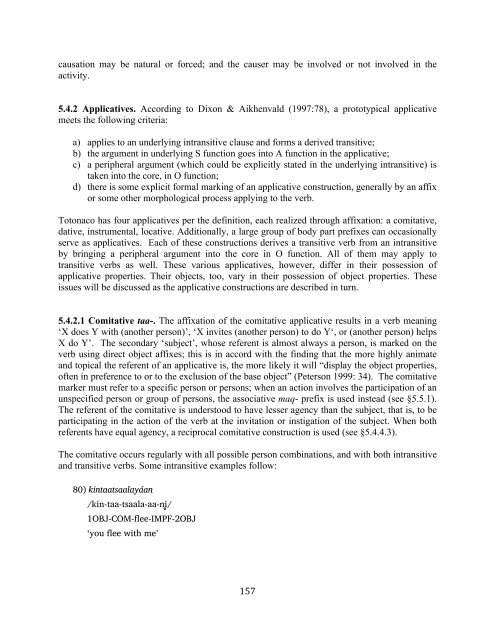The phonology and morphology of Filomeno Mata Totonac
The phonology and morphology of Filomeno Mata Totonac
The phonology and morphology of Filomeno Mata Totonac
You also want an ePaper? Increase the reach of your titles
YUMPU automatically turns print PDFs into web optimized ePapers that Google loves.
causation may be natural or forced; <strong>and</strong> the causer may be involved or not involved in the<br />
activity.<br />
5.4.2 Applicatives. According to Dixon & Aikhenvald (1997:78), a prototypical applicative<br />
meets the following criteria:<br />
a) applies to an underlying intransitive clause <strong>and</strong> forms a derived transitive;<br />
b) the argument in underlying S function goes into A function in the applicative;<br />
c) a peripheral argument (which could be explicitly stated in the underlying intransitive) is<br />
taken into the core, in O function;<br />
d) there is some explicit formal marking <strong>of</strong> an applicative construction, generally by an affix<br />
or some other morphological process applying to the verb.<br />
<strong>Totonac</strong>o has four applicatives per the definition, each realized through affixation: a comitative,<br />
dative, instrumental, locative. Additionally, a large group <strong>of</strong> body part prefixes can occasionally<br />
serve as applicatives. Each <strong>of</strong> these constructions derives a transitive verb from an intransitive<br />
by bringing a peripheral argument into the core in O function. All <strong>of</strong> them may apply to<br />
transitive verbs as well. <strong>The</strong>se various applicatives, however, differ in their possession <strong>of</strong><br />
applicative properties. <strong>The</strong>ir objects, too, vary in their possession <strong>of</strong> object properties. <strong>The</strong>se<br />
issues will be discussed as the applicative constructions are described in turn.<br />
5.4.2.1 Comitative taa-. <strong>The</strong> affixation <strong>of</strong> the comitative applicative results in a verb meaning<br />
‘X does Y with (another person)’, ‘X invites (another person) to do Y‘, or (another person) helps<br />
X do Y’. <strong>The</strong> secondary ‘subject’, whose referent is almost always a person, is marked on the<br />
verb using direct object affixes; this is in accord with the finding that the more highly animate<br />
<strong>and</strong> topical the referent <strong>of</strong> an applicative is, the more likely it will “display the object properties,<br />
<strong>of</strong>ten in preference to or to the exclusion <strong>of</strong> the base object” (Peterson 1999: 34). <strong>The</strong> comitative<br />
marker must refer to a specific person or persons; when an action involves the participation <strong>of</strong> an<br />
unspecified person or group <strong>of</strong> persons, the associative maq- prefix is used instead (see §5.5.1).<br />
<strong>The</strong> referent <strong>of</strong> the comitative is understood to have lesser agency than the subject, that is, to be<br />
participating in the action <strong>of</strong> the verb at the invitation or instigation <strong>of</strong> the subject. When both<br />
referents have equal agency, a reciprocal comitative construction is used (see §5.4.4.3).<br />
<strong>The</strong> comitative occurs regularly with all possible person combinations, <strong>and</strong> with both intransitive<br />
<strong>and</strong> transitive verbs. Some intransitive examples follow:<br />
80) kintaatsaalayáan<br />
/kin-taa-tsaala-aa-ni& &/<br />
1OBJ-COM-flee-IMPF-2OBJ<br />
‘you flee with me’<br />
! ")+!

















